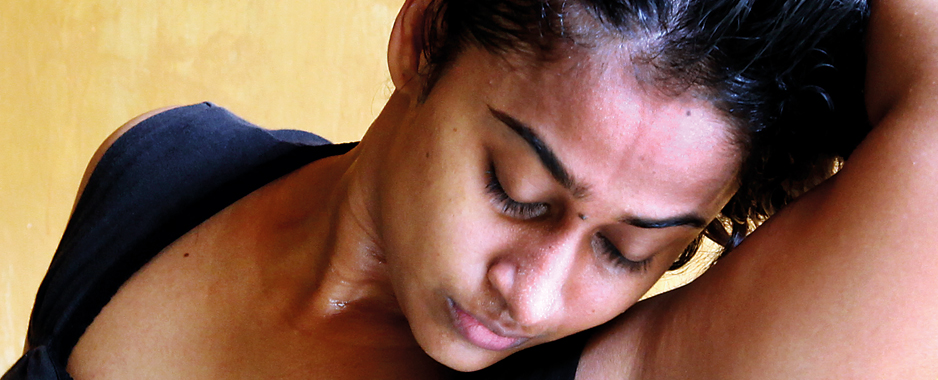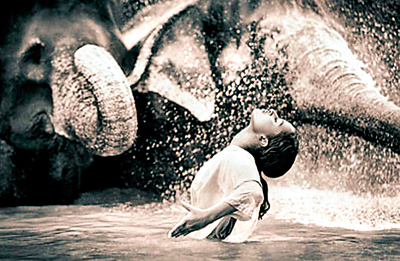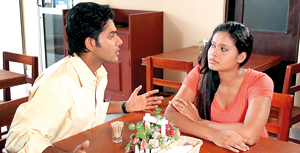Moving both body and mind
The 12 women in Venuri Perera’s weekly movement class at the Halfway Home in Mulleriyawa are getting used to dancing without music. Diagnosed and treated for mental illnesses, they are in recovery from conditions that range from schizophrenia and depression to the milder learning disorders. Venuri is only a few classes in, but she knows what’s she’s working toward establishing – a space of absolute trust and healing creativity. “I tell them, ‘There is no right, there is no wrong, there is no ugly, there is no beautiful. This is a safe space for you to try something new.’”

A dancer who seeks answers to questions. Pic by M.A. Pushpa Kumara
Venuri who has taught technique classes and facilitated creative movement workshops in Sri Lanka, India, UK, and Cambodia has found movement therapy appeals to all sorts of people – she’s used it while working with young children and the visually impaired, and even found fans among the over 60 crowd.
Venuri’s strategy is based not on dance as we know it, but on movement. We don’t always realise it, but our bodies can speak louder and clearer than our voices. We register the language of posture and gesture in our sub-conscious with an unrivalled clarity. One aspect of movement and dance therapy is the use of simple exercises that can have an extraordinary impact – most noticeably in how they affect the people who do them together. “You can achieve an incredible level of closeness and trust within hours,” says Venuri, explaining that there is a strong, profound connection established when you trust your body to someone else or abandon words to communicate on the level of movement alone.
Her work at Mulleriyawa is one answer to a question Venuri has been struggling with for a long time: that of how to reconcile her two resumes. (Depending on who her would-be employer is, they receive one or the other, but seldom both.) She is interested in Psychology – a possible career path bolstered by the listing in her C.V of a B.A, First Class followed by an M.A with distinctions in the subject from an Indian college. She put her degree to work at the Family Rehabilitation Centre where she was employed as a psychologist, supporting, supervising, monitoring and training counsellors in the North and East.
Whatever she has been doing though, Venuri’s love for dance has always taken precedence, earning her a reputation as one of the country’s most talented artists. She completed her post graduate studies in ‘Dance in the Community’ at Laban, London’s conservatoire for contemporary dance (in 2008, she received their Michelle Simone Award for Outstanding achievement in choreography.) She has presented her work here, in the UK, and in India and has performed in dance and theatre productions in India, England, Scotland, Spain, Japan and most recently in Germany when she toured with Gerda Konig’s contemporary dance theatre production ‘Changeable Cohesion’ and was one of the stand out performers. (In Cologne, the troupe bagged a nomination in the ‘Best Contemporary Dance’ category – they’ll know whether they’ve won in November.)
Venuri’s love of her art is innate. She remembers that as a little girl, her parents would have to tear her away from the dance floor. In school, she loved being part of a fabulous “gang of girls” responsible for more than one award-winning performance at Bishop’s College. Later, she appeared as a graceful, lithe teenager in the footage from a stunning documentary film ‘Ashes and Snow’ by Canadian artist Gregory Colbert. Dancing with elephants and birds, she seems utterly immersed in the experience. (The footage is a part of a much larger exhibit, one that has drawn an estimated 10 million viewers.)

Venuri in the documentary ‘Ashes and Snow’
Her serious training though came from the Chitrasena Vajira Kalayathanaya, where she was enrolled as a seven-year-old. She had the privilege of studying under first Vajira herself and then under her daughter Upeka – both of whom laid the strong foundation in Kandyan dance and inculcated a discipline that Venuri gratefully says she has counted on ever since. She was an active member for over a decade and last performed with them in 2007 when she played the Ant Queen in Kumbi Kathawa.
Venuri credits her time at Laban with opening her eyes to how a performance could be about more than its aesthetics. “As dancers I think it’s time we started asking questions: why do we dance? What do we want to say with it? Is it about preserving the tradition or is it about entertaining people or is it about having a voice?” These questions are on her mind as she prepares to debut another original piece at the upcoming Colombo Dance Platform which is sponsored by the Goethe Institute. Venuri who is the coordinator of both the Dance Forum and the platform itself, is collaborating closely with the poet Kumari Kumaragamage and video artist Nadya Perera on her performance.
The title of Kumari’s second book of poetry in Sinhala is translated as ‘For the Ears that Haven’t Heard’. “She’s had a lot of experience living and working in the north and east, and she’s written this book of poems based on things she’s seen and people she’s met,” says Venuri, describing the poems as simply written yet very powerful. For her as the choreographer, the project offers a real challenge. How does a community survive terrible loss? What are the logistics of rebuilding lives? Who decides how it should be done? “These are questions that I’m asking, that Kumari’s asking and that I would like our audience to think about,” says Venuri.
If ‘Abhinishkramanaya, Soldier’, the piece she performed at the last Colombo Dance Platform, is anything to go by, Venuri will push the envelope with this performance. Though she hides it well, it takes her courage to get out there. Its unusual choreography and the lack of music made her “scared to show it here,” says Venuri of the piece that won her honours at Laban. This is in part because she is clear that she doesn’t want to alienate her audience but carry them along. As much as she believes there’s a desperate need for support and space for contemporary dancers in Sri Lanka, she sees equally the lack of engaged audiences. Venuri would like it to be a shared experience and conversation rather than a straightforward exchange of money for entertainment.
She’s pleased to have found likeminded souls in the theatre company Floating Space, where she is now a permanent member. Their interest in different ways of approaching performance has drawn her in and she’s looking forward to their work on upcoming projects such as one with the UK based company Sally E. Dean. She will also soon begin serving as a visiting lecturer on Technique and Improvisation for the Sri Lanka Foundation Institute’s first ever Diploma in Choreography. Both the idea of teaching students who are themselves teachers and sitting in on some of the lectures given by pre-eminent Sri Lankan performers has her looking forward to diving right in.
As far as Venuri is concerned, these are all signs that Sri Lanka’s contemporary dance scene is finally gathering momentum. She admits it’s both a privilege and a struggle to be part of a fledgling movement, but it has its own rewards. “This is an exciting time in Sri Lanka and it’s an important time, because we can go in many different directions,” she says.
Follow @timesonlinelk
comments powered by Disqus



























